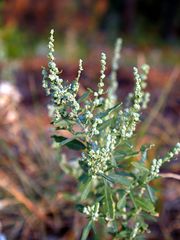Difference between revisions of "Goosefoot seed"
Jump to navigation
Jump to search
| Line 3: | Line 3: | ||
The flat hard seeds from the weedy goosefoot (''Chenopodium'') plant. The seeds are used to produce the artificially granular surface of [[shagreen]] leather. They are thickly scattered on the ground, then untanned pelts are placed on top and trampled. The husks of the seeds make indentations in the skin while the seed oils tan the skins. | The flat hard seeds from the weedy goosefoot (''Chenopodium'') plant. The seeds are used to produce the artificially granular surface of [[shagreen]] leather. They are thickly scattered on the ground, then untanned pelts are placed on top and trampled. The husks of the seeds make indentations in the skin while the seed oils tan the skins. | ||
| − | + | [[File:Quinoavt.jpg|thumb|Quinoa ''Chenopodium quinoa'']] | |
== Synonyms and Related Terms == | == Synonyms and Related Terms == | ||
''Chenopodium'' (goosefoot); Gåsefod (Dan.); Ganzenvoet (Ned.); bluebush; chualar | ''Chenopodium'' (goosefoot); Gåsefod (Dan.); Ganzenvoet (Ned.); bluebush; chualar | ||
| − | |||
| − | |||
| − | |||
| − | |||
| − | |||
| − | |||
== Resources and Citations == | == Resources and Citations == | ||
Latest revision as of 08:31, 30 August 2022
Description
The flat hard seeds from the weedy goosefoot (Chenopodium) plant. The seeds are used to produce the artificially granular surface of Shagreen leather. They are thickly scattered on the ground, then untanned pelts are placed on top and trampled. The husks of the seeds make indentations in the skin while the seed oils tan the skins.
Synonyms and Related Terms
Chenopodium (goosefoot); Gåsefod (Dan.); Ganzenvoet (Ned.); bluebush; chualar
Resources and Citations
- Hermann Kuhn, Conservation and Restoration of Works of Art and Antiquities, Butterworths, London, 1986
- Encyclopedia Britannica, http://www.britannica.com Comment: "goosefoot." Accessed 31 Oct. 2004 .
- USDA-NRCS PLANTS database at plants.usda.gov
- Wikipedia: http://en.wikipedia.org/wiki/Goosefoot (Accessed Jan. 25, 2006)

